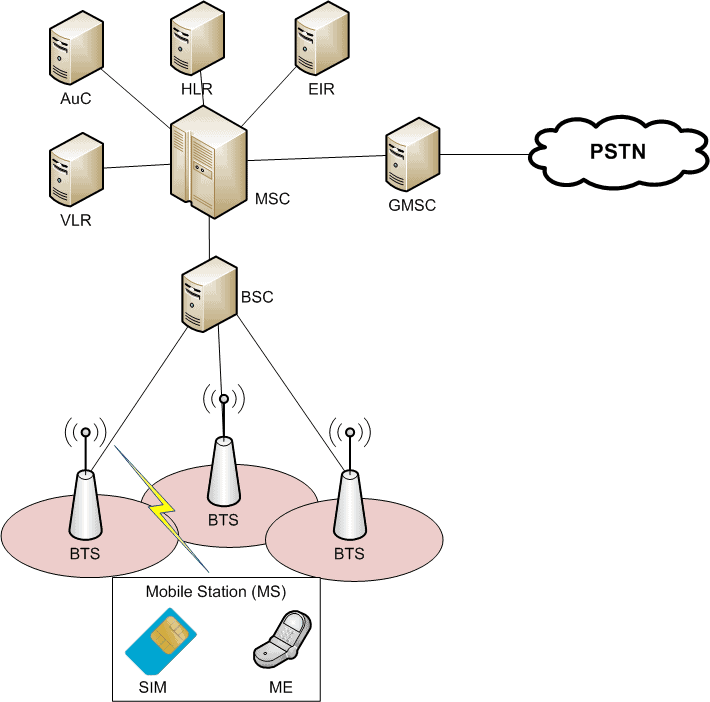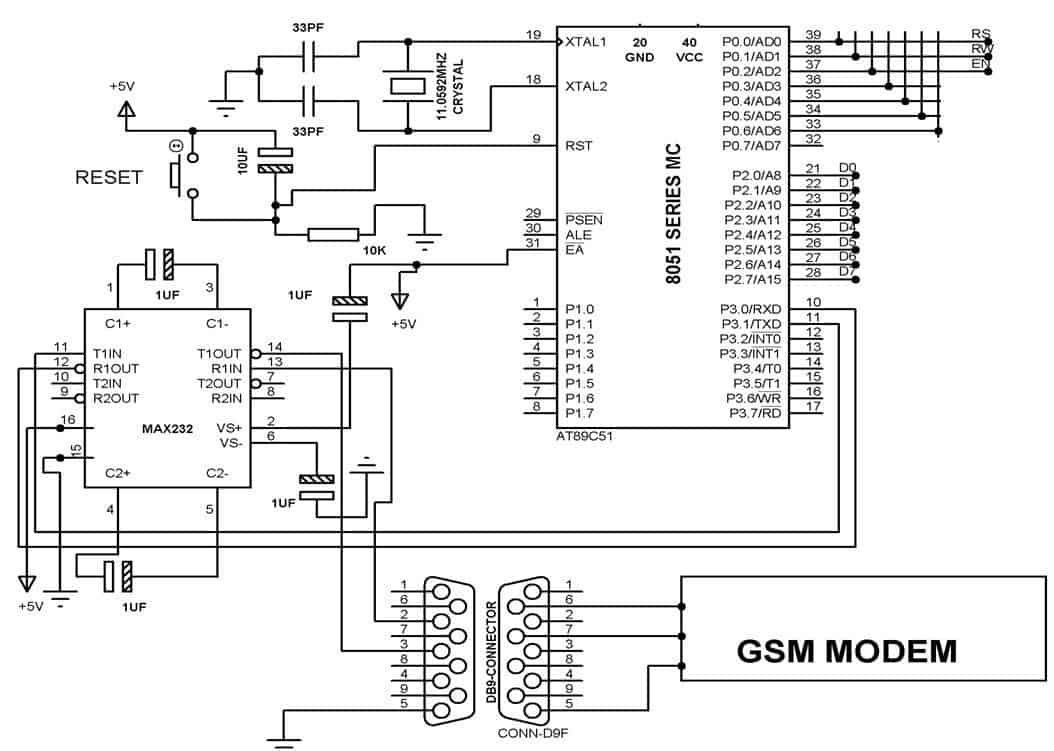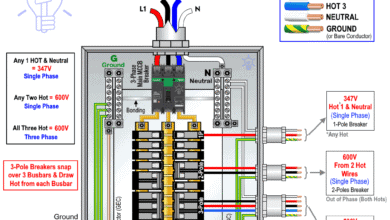What is GSM and How does it Work?
What is GSM (Global System for Mobile communication)
Introduction to GSM Technologies
GSM or Global System for Mobile Communications is the most popular wireless cellular communication technique, used for public communication. The GSM standard was developed for setting protocols for second generation (2G) digital cellular networks.
It initially started as a circuit switching network, but later packet switching was implemented after integration General Packet Radio Service (GPRS) technology as well. The widely-used GSM frequency bands are 900 MHz and 1800 MHz.
In the Europe and Asia, the GSM operates in 900 to 1800 MHz frequency range, whereas in United States and other American countries, it operates in the 850 to 1900 MHz frequency range. It uses the digital air interface wherein the analog signals are converted to digital signals before transmission. The transmission speed is 270 Kbps.
Global System for Mobile Communications (GSM) is currently used by about 80% of mobile phones across the worlds. There are about more than three billion users of this technology.
- Also Read: What is ZigBee Technology and How it works?
GSM History
The standard GSM was first developed in 1982 by a committee of Conference Europeenne des Postes et Telecommunications (CEPT) (Recent – European Telecommunications Standard Institute), the European Standard Organization, as a new mobile communications standard in the 900 MHz frequency band.
The main goal was to provide a uniform international standard for wireless mobile communications. The first GSM based mobile services were started in 1991 in Finland and the acronym changed to Global System for Mobile Communications. At the same time the first digital cellular system was formed which was based on GSM recommendations and later known as GSM-1800.
GSM Architecture
The GSM architecture is divided into Radio Subsystem, Network and Switching Subsystem and the Operation Subsystem. The radio sub system consists of the Mobile Station and Base Station Subsystem.
The mobile station is generally the mobile phone which consists of a transceiver, display and a processor. Each handheld or portable mobile station consists of a unique identity stored in a module known as SIM (Subscriber Identity Chip). It is a small microchip which is inserted in the mobile phone and contains the database regarding the mobile station.
Fig – GSM Network architecture
The base station subsystem
It connects the mobile station with the network subsystem via the air interface.
It consists of the below given elements:
Base Transceiver Station: One or more Base Transceiver Station provides physical connection of a mobile station to the network in form of air interface. Depending on load, subscriber behavior and morph structure, it can have different configurations – Standard configuration (Each BTS is assigned a different cell identity (CI) and several BTS forms a location area).
Umbrella Cell configuration (One BTS with high transmission power installed at a higher altitude, acting as an umbrella to the lower transmission power Base Transmitter Stations), Collocated configurations (several BTSs collocated at one site, but antennas cover only area of 120 or 180 degrees). It is a network of neighboring radio cells which provide a complete coverage of the service area.
Base Station Controller: It controls operation of one more Base Transceiver Stations, basically the handover or power control. A BSC connects to the BTS over a Abis-interface. It consists of a database comprising the whole maintenance status of the BTS, quality of radio and terrestrial resources and BTS operations software).
Transcoding Rate and Adaption Unit: It is located between a Base Station Controller and a Mobile Switching Centre. It compresses or decompresses speech from the mobile station. However, it is not used for data connections.
Network Switching Subsystem: It provides the complete set of control and database functions needed to set up a call using encryption, authentication and roaming features. It basically provides network connection to the Mobile Station. It consists of the below given elements
Mobile Switching Centre: It is the main element within the overall GSM network. It is like a Public Switched Telephone Network (PSTN) exchange or Integrated Services Digital Network (ISDN) exchange. Apart from the normal functionary, it supports additional functionality like registration, authentication, call location and call routing to the subscriber.
It provides interfaces to Public Switched Telephone Network (PSTN) for connection with landline or interface to another Mobile Switching Centre (MSC) for connection to another mobile phone.
Home Location Register: It is a repository which stores data belonging to large number of subscribers. It is basically a large database which administers data of each subscriber. For security purposes, it maintains subscriber specific parameter such as parameter Ki, known only to the HLR and the SIM.
Virtual Location Register: It is similar to Home Location Register (HLR) , but differs in the fact that it stores dynamic information regarding the subscriber data. It comes to act in case of roaming where a subscriber moves from one location to another. The information is stored in the Equipment Identity Register that maintains account of all mobile stations, each identified by their International Mobile Equipment Identity (IMEI) number.
How GSM communication works?
Global System for Mobile Communications (GSM) uses a combination of Time Division Multiple Access (TDMA) and Frequency Division Multiple Access (FDMA).
Frequency Division Multiple Access: It involves dividing a frequency band into multiple bands such that each sub-divided frequency band is allotted to a single subscriber. FDMA in GSM divides the 25MHz bandwidth into 124 carrier frequencies each spaced 200 KHz apart. Each base station is allotted one or more carrier frequencies.
Time Division Multiple Access: It involves allotting same frequency channel to different subscribers by dividing the frequency band into multiple time slots. Each user gets his/her own timeslot, allowing multiple stations to share same transmission space.
For GSM, each sub divided carrier frequency is divided into different time slots using TDMA technique. Each TDMA frame lasts for 4.164 milliseconds (ms) and contains 8 time slots. Each time slot or a physical channel within this frame lasts for 577 microseconds and data is transmitted in the time slot in form of bursts.
GMS Modem Circuit – Working of GSM Module:
Fig -GMS Modem Circuit – How GSM communication works
Evolving Technologies
Although GSM or 2G communication network is still the preferred network for many subscribers, especially in developing countries like India, owing to its availability and it being economic, yet different communication technologies like Universal Mobile Telecommunications System (UMTS) and Long Term Evolution (LTE) technologies were developed. While UMTS provides 3rd generation wireless communication standards, LTE provides 4th generation wireless communication standards.
So, this is a basic tutorial about GSM communication network. In the last para, I have mentioned about the emerging communication network, LTE. Any information regarding this technique is welcome in the below comments.
You May Also Read:
- What is WiMAX? Difference between Broadband WiMax and WiFi
- Arduino Serial: Serial Communication by Arduino
- What is MEMS – Microelectromechanical Systems Technology ?








